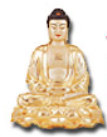
TEACHINGS IN CHINESE
BUDDHISM
BUDDHANET PRODUCTION
(3) A Discussion of The Three-vehicles and One-vehicle Practice
The concept of Three-vehicles practice and One- ehicle practice, has been the ground for much debate by Buddhist scholars. Is the practice of Three- ehicles an expedient path or the ultimate path? Does the One- ehicle mean the practice of Mahayana (greater vehicle) in the Three Vehicles? Does the One- vehicle practice take us further than the Three-vehicle practice? It appears that researchers have not come to any conclusions.
Recently I read the Xiu Xing Dao Di Sutra translated by Dharmaraksa, who is known as Dun Huang Bodhisattva. This author has also translated the Lotus Sutra (Saddharma pundarika Sutra). I found that there is an ancient interpretation of the One-vehicle and the Three- ehicle practice. It is simple and clear, and so today I would like to introduce you to it.
From the view point of aspiration, there are people who are weary of life and death, while others possess the great Bodhicitta (Bodhi-mind). Thus, the former will enter Nirvana, while the latter, Buddhahood. However, since the sentient beings’ spiritual foundations differ, the Buddha taught us many different paths. Consequently there are the paths of the Three-vehicles and the One-vehicle. There are people who practise the greater vehicle and then degrade to the smaller vehicle and vice versa.
The Sravakas
There are two types of Sravakas. The first type are the people who practice the path of the smaller-vehicle and who never cultivate any bodhicitta. They learn and practise the Dharma from the Buddha for their own salvation. They cannot put up with a life that seems meaningless and without ending. Their only pressing problem is to be free from suffering. As long as they are at peace, they do not bother about anyone else. This is the attitude they have towards others. When they hear the worlds of the three realms, they shiver and scare.
Practitioners of this character are weary of not being able to be free from rebirth, and not being able to attain ultimate liberation. For these people, the Buddha condemned the suffering of rebirth, and praised Nirvana. He showed them the abode of the Enlightened Ones and guided them to understand the Four Noble Truths. The Buddha hoped that they could be free from suffering. Practitioners of this character believe that they have reached the ultimate path. They do not automatically progress to cultivate the path of the greater vehicle. The Buddha will have to wait for the moment when they are about to enter into Nirvana to show them the path of the greater-vehicle. They will then realize that they have not attained the ultimate practice and be encouraged to develop their bodhicitta.
The second type are those who have compassion but find it difficult to practice. They practise giving, the precepts, meditation, wisdom, and aim at freeing themselves from rebirth. They vigorously meditate and contemplate so that they may attain eternal Nirvana. However, they know that the attainment of arahantship is not the ultimate goal. Thus they automatically want to follow the path of the Bodhisattva. They learn from the teachings of the Buddha and develop themselves to seek the greater path. They cultivate their great loving kindness and compassion and the Six Perfections, progressing towards the state of non attachment and emptiness. They may even choose to be reborn in order to teach and save sentient beings.
Pratyeka-Buddhas
Pratyeka-Buddhas are those who once developed themselves to cultivate their bodhicitta, but gave up the practice at a later stage. They had the bodhicitta, but forgot it and lost their aim. They may have also practised the Six Perfections, and meditated on the Buddha but became attached to the physical phenomena of the manifestations.
For sentient beings with spiritual foundation as such, the Buddha taught them the path of the Three-vehicles. The fact that there was Buddha born in the world, these practitioners would lead a life of the hermit, live in a remote mountain cave or hut by themselves, contemplate and observe the existence of the myriad beings. They would realize that all existences are subject to causes and conditions and subsequently gain enlightenment.
The two types of practitioners above, have similar characteristics. They have initiated their bodhicitta, but did not progress further into its deeper context. They attach themselves too much to the well-being of the physical manifestations of the Buddha. However, eventually they may come back to seek the greater path. When they have ended rebirth and entered Nirvana, the Buddha will show them “the path of Mahayana which integrates the Three-vehicle”, and they will detach themselves from the realms of existence and Nirvana, and progress along the path of the great vehicle.
The Path of the Bodhisattvas
Bodhisattvas are practitioners who have cultivated their bodhicitta. Apart from those who later degenerate to become pratyeka-buddhas, we can further divide such practitioners into two groups.
1. There are those who will follow a gradual and progressive path. They realize that the three realms of existence are merely illusions and that all phenomena are void. They practice the Six Perfections vigorously and accumulate boundless merits. One step after another, they go forward. Eventually they possess skilful means, and gain enlightenment via expedient path. They attain the stage of no rebirth, and their position never recedes.
2. Then there are those who find instant attainment. They gain the stage of no rebirth, and do not recede as soon as they cultivate their bodhicitta. They immediately understand the immaterial personality and voidness of all myriad beings. They realize that all manifestations are void and are non-obtainable and non-distinguishable
The Awakened Mind Clings To Nothing
Does mental defilement pollute and constrain our mind? Because of our ignorance, we attach to our ego and possessions. We are constrained by them. If we are free from attachments, and do not cling to any belongings, then we will be free from suffering. This is the ancient patriarch’s teaching in guiding practitioners to the stage of no rebirth.
The teaching continues; “The wise ones observe the three realms of existence. They realize that the Five Skhandas are illusions. When they realize that there is no external object to cling to, they attain the state of no rebirth.” There is no fast track nor short cut to the path of Bodhi. When the mind understands that the source of all is void, it’s like suddenly seeing the light at the end of a tunnel. We do not feel in a state of gain or loss, past or present, when we attain this wisdom. The awakened mind clings to nothing. It understands the absolute truth and the void nature of all things.
It attains understanding of voidness, equality, and great wisdom. It does not attach itself any longer to the three realms of existence nor Nirvana. Nor will it attach itself to the fact that it is ferrying the suffering sentient beings over to the other shore of Nirvana. Neither will it attach itself to attaining Buddhahood. It will work vigorously to cultivate the Six Perfections. The awakened mind will utilize the expedient path to help all beings. These are the ones who have the Bodhisattva spiritual foundation. (According to the Nagarjuna Bodhisattva, this spiritual foundation can be further divided into three different levels.)
The aim of returning to one path allows us to concentrate on attaining the universal wisdom of understanding the truth of voidness. Generally speaking, cultivating the path of the greater-vehicle is equivalent to practising the One-vehicle. But the teachings of Buddha-Dharma propagate according to the minds and the conditions of the time and space. The classification of the Three Vehicle or One Vehicle depends on the practitioner’s mind and aspiration. It is rather common for practitioners to classify which sutra or teaching is the greater vehicle, and which is the smaller vehicle. In fact, this is not the right way of classification. There are people who practice the Mahayana path, but who do not attain the Mahayana goal. Sometimes they may even deteriorate to follow other beliefs. This commonly happens.
The point is, practitioners should always examine their motivation of practice — is it for the sake of freeing themselves from rebirth? Or to ferry all sentient beings to attaining enlightenment? How do we practise the Dharma? Are we practising the path of relieving ourselves, or the path of the Six Perfections? What do we realize? Do we attach ourselves to phenomena and existence? Have our minds realized voidness and thus attained the stage of no rebirth? Eventually all sentient beings will become Buddhas and realize the great wisdom of the One-vehicle. But before we come to that stage, we cannot classify ourselves as the practitioners of One-vehicle simply because we are reading the One-vehicle sutra or learning the One-vehicle Dharma!
(Translated by Lim Yang, edited by Ke Rong, proofread by Shi Neng Rong. (6- 7-96)

